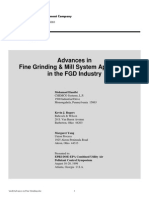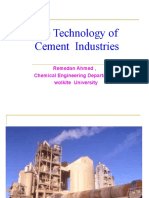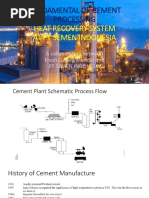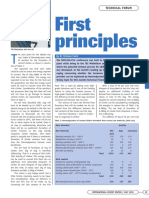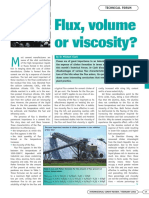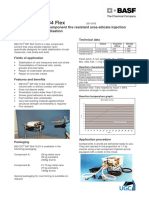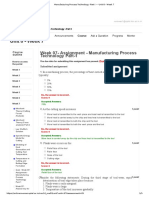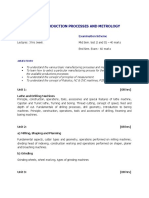0 ratings0% found this document useful (0 votes)
74 viewsCost & Quality of Homogeneity
Cost & Quality of Homogeneity
Uploaded by
Elwathig BakhietThe document discusses the efforts cement companies make to achieve homogenous raw materials and consistent clinker production. It aims to reduce variability at each stage from raw material extraction and mixing to kiln operation. The author questions if full investment in homogenization equipment is always needed and suggests balancing the inherent raw material variability with the variation tolerable for clinker quality.
Copyright:
© All Rights Reserved
Available Formats
Download as PDF, TXT or read online from Scribd
Cost & Quality of Homogeneity
Cost & Quality of Homogeneity
Uploaded by
Elwathig Bakhiet0 ratings0% found this document useful (0 votes)
74 views2 pagesThe document discusses the efforts cement companies make to achieve homogenous raw materials and consistent clinker production. It aims to reduce variability at each stage from raw material extraction and mixing to kiln operation. The author questions if full investment in homogenization equipment is always needed and suggests balancing the inherent raw material variability with the variation tolerable for clinker quality.
Original Description:
free
Copyright
© © All Rights Reserved
Available Formats
PDF, TXT or read online from Scribd
Share this document
Did you find this document useful?
Is this content inappropriate?
The document discusses the efforts cement companies make to achieve homogenous raw materials and consistent clinker production. It aims to reduce variability at each stage from raw material extraction and mixing to kiln operation. The author questions if full investment in homogenization equipment is always needed and suggests balancing the inherent raw material variability with the variation tolerable for clinker quality.
Copyright:
© All Rights Reserved
Available Formats
Download as PDF, TXT or read online from Scribd
Download as pdf or txt
0 ratings0% found this document useful (0 votes)
74 views2 pagesCost & Quality of Homogeneity
Cost & Quality of Homogeneity
Uploaded by
Elwathig BakhietThe document discusses the efforts cement companies make to achieve homogenous raw materials and consistent clinker production. It aims to reduce variability at each stage from raw material extraction and mixing to kiln operation. The author questions if full investment in homogenization equipment is always needed and suggests balancing the inherent raw material variability with the variation tolerable for clinker quality.
Copyright:
© All Rights Reserved
Available Formats
Download as PDF, TXT or read online from Scribd
Download as pdf or txt
You are on page 1of 2
p59 60 Forum DH
24/11/04
2:44 pm
Page 1
TECHNICAL FORUM
I Cost and value of homogenity
by Dr Michael Clark
The cement industry around the world expends a great deal of effort and
money in the pursuit of homogeneity. The most conspicuous effort goes
into reducing the variability of the raw mix delivered to the cement kiln.
That has to be supplemented by consistent fuel supply to the kiln, in
particular with respect to the ash content. Kiln feed and fuel of low
variability then have to be combined with stable operation of the kiln to
produce a clinker of consistent mineralogy and hydraulic reactivity.
Feeding the plant with well
homogenised raw material
is crucial for consistent
high quality clinker
nce that consistent clinker has
been produced the efforts need
to focus on ensuring that
variability in cement performance is not
induced in either the clinker storage and
handling systems or the cement milling
process. The hydraulic performance of
clinker will change in storage due to
relaxation of the stresses and strains in the
clinker mineral structure induced by rapid
cooling. Extraction of clinker from storage
needs to take this into consideration to
produce a consistent cement. Clinker
stock rotation and management is the
way to achieve this. Cement milling
Raw milling stage where corrective
materials can be added
systems have to be set up and maintained
to produce cements with the same particle
size distribution to prevent variability
between different mills. If all these
procedures are in place the customers of
the cement company receive cement with
predictable hydraulic performance and
they in turn can then optimise their
processes for the production of concrete.
Returning to the reduction of the
variability of the raw mix delivered to the
kiln the efforts begin with the geological
surveying and core drilling of the raw
material deposits to establish their
inherent variability. Calcium carbonate,
CaCO3, is the primary raw material for
cement manufacture, usually in the form
of limestone or chalk. This calcium
carbonate must be combined with other
raw materials which will provide the acidic
silica, alumina and iron oxide required to
combine with the lime liberated from the
calcium carbonate in the cement kiln.
Most calcium carbonate deposits contain
contaminants which provide part of these
requirements. The level and variability of
these contaminants must be established to
determine which supplementary raw
materials will be required to produce a kiln
feed of the necessary lime saturation, silica
and alumina modulus which will in turn
combine to produce a clinker of the
desired mineralogy.
After the inherent variability in the raw
materials has been established along with
the requirements for supplementary
materials to adjust the chemistry of the
mix the equipment can be specified to
bring these together into a raw mix of low
variability. If more than one raw material
are to be mixed at the crusher then
different feeders can be provided for each
material. The speeds and delivery rate of
these feeders can be automatically
adjusted based on the feedback from
continuous composition measurement
devices using PGNAA (prompt gamma
neutron activation analysis) technology.
After the crusher and the PGNAA device
the variability in the crushed raw material
stream can be smoothed out in a blending
bed.
From the blending bed the
homogenous raw material passes to the
raw milling for fine grinding and drying.
At this stage consideration has to be given
in the operation and design of the plant to
ensuring that variability is not induced in
the blended raw materials by intermediate
storage bins. Final corrective raw materials
are often added at the raw milling stage
and these must be proportioned into the
mill in the required quantities. The raw
mill product then usually passes to a
continuous or batch blending system
before being delivered to the cement kiln.
At this late stage in the process variability
n the clinker produced form the kiln can
be introduced via the handling of the
precipitator dust. It is a matter of
considerable debate whether this dust
should be directed to the homogenisation
silo or directly back to the kiln feed. To
DECEMBER 2004 ICR 59
p59 60 Forum DH
24/11/04
2:44 pm
Page 2
the homogenisation silo is often preferred when the raw mill
is running as the precipitator dust is then mixed with the
raw mill product. However, when the raw mill is stopped a
slug of pure dust, usually with high lime saturation, is input
to the silo. Always directing the dust to the kiln feed avoids
these mill on/mill off problems.
So the solutions to proportioning and intimately mixing
the raw materials to produce a homogenous kiln feed are
known. If all this equipment is installed a cement company
will be faced with a capital investment requirement of
between US$5m and US$10m. Is all this equipment
necessary in every case, or can some of this investment be
saved? Is there some overlap or duplication in the
equipment?
These are not easy questions to answer, but are worth
asking when a new cement factory is being specified and
designed. With the ongoing drive to use alternative fuels
and raw materials to manufacture cement these are also
relevant considerations for existing cement factories. Quite
possibly some or all of these mixing or monitoring
equipments might need to be retrofitted to the process.
Answering the questions requires consideration of the
homogenisation task from both ends. How much variation is
there in the raw materials? If the raw material is a marl
approaching the composition of cement rock with very
little variation then there would be no point in spending the
capital to install multiple crusher feeders, PGNAA equipment
or blending beds. The variation is given by the maximum
and minimum lime, silica alumina and iron oxide contents of
the core drilling samples. These cores are usually split into
one, two or five metre sections before analysis. The analyses
of these sections should be inspected to detect any outliers
and statistical process control then tells us that the range of
the compositions will encompass three standard deviations
of the actual composition variation that will be experienced
in practice.
From the other end of the problem what is the maximum
variation in kiln feed that a cement kiln can contend with a
produce a clinker of consistent and predictable hydraulic
performance? Convention is that less than one per cent
standard deviation in kiln feed LSF is attainable and that this
will result in a uniform clinker product (provided that there
is no large variation in fuel ash or the operation of the kiln).
Knowledge of the inherent variation and the final required
variation can then be combined with the reduction in
variation that is typically achieved by the different items of
equipment to decide which equipment needs to be installed.
Simply blasting and loading the rock will reduce the inherent
variation by approximately 20 per cent. Stockpiling at the
crusher can reduce variation by up to 40 per cent. A
blending bed can achieve 75 to 90 per cent reduction in
variation. At the raw grinding stage 30 per cent reduction in
variation can be achieved. Continuous homogenisation silos
will reduce variation by around 75 per cent. A batch
homogenisation system has greater capability and can
reduce variation by 85 per cent. Armed with these
benchmarks a cement company is able to make a rational
decision as to the level of investment required to produce a
consistent clinker product.____________________________ I
60 ICR DECEMBER 2004
You might also like
- SSPC PCS Exam Preparation GuideDocument4 pagesSSPC PCS Exam Preparation Guidetaimoor faisal100% (1)
- Wear Impact in Slag GrindingDocument15 pagesWear Impact in Slag GrindingKenny Ruiz100% (2)
- Everything You Need To Know About The Chemistry of Kiln Feed and ClinkerDocument16 pagesEverything You Need To Know About The Chemistry of Kiln Feed and ClinkerrpazbNo ratings yet
- Project Report ON Proposed Coal Washing Plant AT Korba AreaDocument23 pagesProject Report ON Proposed Coal Washing Plant AT Korba AreaAmitesh Joseph75% (4)
- Additives For A Challenging Cement MarketDocument5 pagesAdditives For A Challenging Cement MarketkidcatNo ratings yet
- Everything You Need To Know About Kiln System Operations in Cement Manufacturing - INFINITY FOR CEMENT EQUIPMENTDocument40 pagesEverything You Need To Know About Kiln System Operations in Cement Manufacturing - INFINITY FOR CEMENT EQUIPMENT06062015nNo ratings yet
- Concrete Fundamentals: Stages in Cement DevelopmentDocument9 pagesConcrete Fundamentals: Stages in Cement DevelopmentAafan ShahidNo ratings yet
- Small-Scale Production of Portland Cement (HABITAT, 1993, 92 P.) V. Raw-Mix Design and Quality Control in VSK Cement Plants 5.1 Raw-Mix DesignDocument3 pagesSmall-Scale Production of Portland Cement (HABITAT, 1993, 92 P.) V. Raw-Mix Design and Quality Control in VSK Cement Plants 5.1 Raw-Mix DesignshastrysnNo ratings yet
- Cement Plant Op HandbookDocument31 pagesCement Plant Op Handbookneerav saxenaNo ratings yet
- Optimizing Raw Mills PerformanceDocument9 pagesOptimizing Raw Mills PerformanceIrshad HussainNo ratings yet
- Grinding Clinker Replacement MaterialsDocument15 pagesGrinding Clinker Replacement MaterialsindrabudhiNo ratings yet
- Bogue Vs ChromyDocument2 pagesBogue Vs ChromyElwathig BakhietNo ratings yet
- Advances in Fine Grinding & Mill System Application in The FGD IndustryDocument6 pagesAdvances in Fine Grinding & Mill System Application in The FGD IndustrychantivsNo ratings yet
- Basic CementDocument8 pagesBasic CementRandy WiranataNo ratings yet
- Kiln Control Using Continuous On-Stream XRD: A Proven TechnologyDocument8 pagesKiln Control Using Continuous On-Stream XRD: A Proven TechnologySiti Hanna100% (1)
- Survival Fuels: Technical ForumDocument2 pagesSurvival Fuels: Technical ForumElwathig Bakhiet100% (1)
- Advanced Control Schemes For Cement Fabrication Processes: Susana Arad, Victor Arad and Bogdan BoboraDocument27 pagesAdvanced Control Schemes For Cement Fabrication Processes: Susana Arad, Victor Arad and Bogdan BoboraBeben Efendi BenzyNo ratings yet
- Optimizing Raw Mills PerformanceDocument14 pagesOptimizing Raw Mills PerformanceLe HoangNo ratings yet
- Cement IndustryDocument8 pagesCement IndustrykefzNo ratings yet
- Cement Mill: History Materials Ground Temperature Control Ball MillsDocument5 pagesCement Mill: History Materials Ground Temperature Control Ball MillsAli HadiNo ratings yet
- Advantages of Low Volatile Coals For PCIDocument24 pagesAdvantages of Low Volatile Coals For PCIKUNALJAYNo ratings yet
- Tips to Save Energy in Cement Manufacturing Process - Infinity for Cement EquipmentDocument11 pagesTips to Save Energy in Cement Manufacturing Process - Infinity for Cement EquipmentReda Shewit GebretsadikNo ratings yet
- Industrial Geology SGL 358Document8 pagesIndustrial Geology SGL 358mktbalrsalt2No ratings yet
- 333 PDFDocument26 pages333 PDFdineshhissarNo ratings yet
- OptimizingRawMillsPerformance theMaterialsWAY 1670142333901Document17 pagesOptimizingRawMillsPerformance theMaterialsWAY 1670142333901YhaneNo ratings yet
- Pyro Process 01Document61 pagesPyro Process 01Galata BaneNo ratings yet
- Gujarat Sidhee Cement Limited-SmitDocument26 pagesGujarat Sidhee Cement Limited-SmitHimadri MahatoNo ratings yet
- Fly Ash Brick Making Plant Cement FinalDocument14 pagesFly Ash Brick Making Plant Cement FinalSudheer AmbiNo ratings yet
- Wear Impacts in Slag Grinding in Various Grinding TechnologiesDocument15 pagesWear Impacts in Slag Grinding in Various Grinding TechnologiesrndNo ratings yet
- Continuous Gravity Concentration in Gold Grinding CircuitsDocument5 pagesContinuous Gravity Concentration in Gold Grinding CircuitsTarek AounNo ratings yet
- News 2013 12Document12 pagesNews 2013 12leekiangyen100% (1)
- Advances in Fine GrindingDocument7 pagesAdvances in Fine GrindinganruloNo ratings yet
- CementDocument65 pagesCementHayimanot Yirga100% (1)
- CEMENT-WPS OfficeDocument6 pagesCEMENT-WPS OfficebollywumNo ratings yet
- Belt Bucket Elevator Design-EXAMPLEDocument11 pagesBelt Bucket Elevator Design-EXAMPLEkingNo ratings yet
- Common Problems in Cement PlantDocument6 pagesCommon Problems in Cement PlantYhane100% (1)
- Common Problems in Cement Plant: One Issue From Each SectionDocument7 pagesCommon Problems in Cement Plant: One Issue From Each SectionYhaneNo ratings yet
- Cementppt Nov13Document75 pagesCementppt Nov13Gabriel AyauNo ratings yet
- Ultra Tech Cement TadipatriDocument18 pagesUltra Tech Cement TadipatriAshutosh SinghNo ratings yet
- Variation of Feed Chemical Composition and Its Effect On Clinker Formation PDFDocument7 pagesVariation of Feed Chemical Composition and Its Effect On Clinker Formation PDFs_prasy6540No ratings yet
- Title: AuthorsDocument14 pagesTitle: AuthorsKrishnadas GopalakrishnanNo ratings yet
- Lehigh CementDocument7 pagesLehigh CementAhmed ElhosainyNo ratings yet
- Advanced Control Schemes For Cement Fabrication Processes: October 2008Document25 pagesAdvanced Control Schemes For Cement Fabrication Processes: October 2008Rhea MambaNo ratings yet
- Mod - 1 Fundamental of Cement Processing (Autosaved)Document67 pagesMod - 1 Fundamental of Cement Processing (Autosaved)Bambang Murtjahjanto50% (2)
- 2 Fresh Properties of Portland Cement Grouts: S.A.JefferisDocument29 pages2 Fresh Properties of Portland Cement Grouts: S.A.Jefferisraahul_nNo ratings yet
- 003 FP PDFDocument6 pages003 FP PDFansarNo ratings yet
- Process Industries - Lecture Material 5Document30 pagesProcess Industries - Lecture Material 5Barnabas YohannesNo ratings yet
- Process Technology of Cement IndustriesDocument35 pagesProcess Technology of Cement IndustriesHayimanot YirgaNo ratings yet
- Cement PlantDocument15 pagesCement Plantengr.kamran100% (1)
- GAPS Guidelines: Cement ProductionDocument7 pagesGAPS Guidelines: Cement ProductionSachin SalakkiNo ratings yet
- Manufacture of CementDocument12 pagesManufacture of CementNatsir Djafar100% (3)
- Ready Mix ConcreteDocument23 pagesReady Mix ConcreteDevesh Sharma100% (1)
- Cement IndustriesDocument29 pagesCement IndustriesHananNo ratings yet
- An Introduction To Portland Cement ManufacturingDocument23 pagesAn Introduction To Portland Cement ManufacturingSemy Ben ChaabeneNo ratings yet
- Petroleum and Petrochemical Waste Reuse in Cement Kilns: Gossman Consulting, IncDocument11 pagesPetroleum and Petrochemical Waste Reuse in Cement Kilns: Gossman Consulting, IncTruong Giang Vo100% (1)
- Descriptive Pamphlet of the Richmond Mill Furnishing WorksFrom EverandDescriptive Pamphlet of the Richmond Mill Furnishing WorksNo ratings yet
- Ceramic Materials for Energy Applications VIFrom EverandCeramic Materials for Energy Applications VIHua-Tay LinNo ratings yet
- Advances in Materials Science for Environmental and Energy Technologies VIFrom EverandAdvances in Materials Science for Environmental and Energy Technologies VITatsuki OhjiNo ratings yet
- Sewage Disposal Works: Their Design and ConstructionFrom EverandSewage Disposal Works: Their Design and ConstructionNo ratings yet
- Ijfeat: Application of Electrostatic Precipitator in Cement PlantDocument7 pagesIjfeat: Application of Electrostatic Precipitator in Cement PlantElwathig BakhietNo ratings yet
- Refractory Castable SelectionDocument37 pagesRefractory Castable SelectionElwathig Bakhiet100% (4)
- Mineralisation PDFDocument11 pagesMineralisation PDFElwathig BakhietNo ratings yet
- Cement Kiln Process Chemistry: Cemnet Training - Course Ckpc01 Module 2.6 ExerciseDocument1 pageCement Kiln Process Chemistry: Cemnet Training - Course Ckpc01 Module 2.6 ExerciseElwathig BakhietNo ratings yet
- First PrinciplesDocument2 pagesFirst PrinciplesElwathig BakhietNo ratings yet
- Ss PolymorphsDocument9 pagesSs PolymorphsElwathig BakhietNo ratings yet
- Burnability ExercisesDocument1 pageBurnability ExercisesElwathig BakhietNo ratings yet
- First PrinciplesDocument2 pagesFirst PrinciplesElwathig BakhietNo ratings yet
- Alkali CyclesDocument14 pagesAlkali CyclesElwathig BakhietNo ratings yet
- Burnability ExercisesDocument1 pageBurnability ExercisesElwathig BakhietNo ratings yet
- Cement Kiln Process Chemistry: Cemnet Training - Course Ckpc01 Module 3.3 - ExerciseDocument1 pageCement Kiln Process Chemistry: Cemnet Training - Course Ckpc01 Module 3.3 - ExerciseElwathig BakhietNo ratings yet
- Bogue DeviationDocument8 pagesBogue DeviationElwathig BakhietNo ratings yet
- Viscosity PDFDocument1 pageViscosity PDFElwathig BakhietNo ratings yet
- RedoxDocument7 pagesRedoxElwathig BakhietNo ratings yet
- Alkali CyclesDocument14 pagesAlkali CyclesElwathig BakhietNo ratings yet
- Alkali CyclesDocument14 pagesAlkali CyclesElwathig BakhietNo ratings yet
- CO Sources PDFDocument11 pagesCO Sources PDFElwathig BakhietNo ratings yet
- Viscosity PDFDocument1 pageViscosity PDFElwathig BakhietNo ratings yet
- International Cement Review, September 2002: Burning The MixDocument5 pagesInternational Cement Review, September 2002: Burning The MixarylananylaNo ratings yet
- Burnability ExercisesDocument1 pageBurnability ExercisesElwathig BakhietNo ratings yet
- CSAF Exercise PDFDocument1 pageCSAF Exercise PDFElwathig BakhietNo ratings yet
- Minutes of Meeting: Bekapai-3 Surface Facilities Modification and Dogleg Installation (Epcic)Document13 pagesMinutes of Meeting: Bekapai-3 Surface Facilities Modification and Dogleg Installation (Epcic)Arung IdNo ratings yet
- MEYCO MP 364 Flex PDFDocument2 pagesMEYCO MP 364 Flex PDFFrancois-No ratings yet
- Iv Report Malabar CementsDocument12 pagesIv Report Malabar CementsSafanaNo ratings yet
- Unit 8 - Week 7: Week 07-Assignment - Manufacturing Process Technology Part-1Document5 pagesUnit 8 - Week 7: Week 07-Assignment - Manufacturing Process Technology Part-1souparna duttaNo ratings yet
- Recegrout Sl10: Product Data SheetDocument2 pagesRecegrout Sl10: Product Data SheetAmira RamleeNo ratings yet
- SM2-3 Physics and Metallurgy of Welded Joints: Dr. Tarek BEN AMEUR, ProfessorDocument23 pagesSM2-3 Physics and Metallurgy of Welded Joints: Dr. Tarek BEN AMEUR, ProfessorAhmedNo ratings yet
- Tolvas ElcometerDocument13 pagesTolvas ElcometerJose ManuelNo ratings yet
- QW 406 Asme CodeDocument3 pagesQW 406 Asme CodeMardeOpamenNo ratings yet
- Sist en 16125 2019Document12 pagesSist en 16125 2019acsNo ratings yet
- Jewelry Making Tools 1Document29 pagesJewelry Making Tools 1libragrrl100% (5)
- Colligative Properties: Cryoscopy & EbulliosDocument30 pagesColligative Properties: Cryoscopy & EbulliosRSL100% (1)
- 2021 11 Sahlol Unfortunate Start Up NH3 Plant 2010Document9 pages2021 11 Sahlol Unfortunate Start Up NH3 Plant 2010safiehNo ratings yet
- RR 5283Document4 pagesRR 5283majidhajnasrNo ratings yet
- Zincform ASTM A653 Grade 37: General Description: Normal / Optional Supply ConditionsDocument1 pageZincform ASTM A653 Grade 37: General Description: Normal / Optional Supply ConditionsVíctor Silva100% (1)
- Comparativereviewofawsd 11 Csaw 471 Andcsaw 59Document25 pagesComparativereviewofawsd 11 Csaw 471 Andcsaw 59qc_531040655No ratings yet
- Resin Volume in Sockets (Reference Only)Document2 pagesResin Volume in Sockets (Reference Only)Anonymous ntE0hG2TPNo ratings yet
- TDS Therminol 66 Rodun Int GBDocument5 pagesTDS Therminol 66 Rodun Int GBsclad91No ratings yet
- Production Processes and MetrologyDocument3 pagesProduction Processes and MetrologymaheshNo ratings yet
- 2010 Datasheet DMV 825 PDFDocument4 pages2010 Datasheet DMV 825 PDFtaya1401No ratings yet
- Designer PVC LaminatesDocument98 pagesDesigner PVC LaminatesDeepu VijayanNo ratings yet
- Corrosion Protection and StorageDocument3 pagesCorrosion Protection and StorageRaphael LinoNo ratings yet
- The Living Clock: The Orchestrator of Biological Rhythms by John D. Palmer Read Online Book DJVU, DOC, IBOOKSDocument2 pagesThe Living Clock: The Orchestrator of Biological Rhythms by John D. Palmer Read Online Book DJVU, DOC, IBOOKSfoqowerNo ratings yet
- MSS SP-42-1999Document16 pagesMSS SP-42-1999Surat ButtarasriNo ratings yet
- Protective Epoxy Coatings Guide Sherwin WilliamsDocument8 pagesProtective Epoxy Coatings Guide Sherwin WilliamsTeguh SilaNo ratings yet
- Design For MachiningDocument33 pagesDesign For MachiningAnkit chauhanNo ratings yet
- Balaji Industries Catalog For Pharma-Chem Industry (Sakinaka, Mumbai) (64 Pages) (27.03.2023) (Vol 1, Ver 2223)Document64 pagesBalaji Industries Catalog For Pharma-Chem Industry (Sakinaka, Mumbai) (64 Pages) (27.03.2023) (Vol 1, Ver 2223)mosamnpNo ratings yet
- AEC23Document11 pagesAEC23E-19-laxmikant reddyNo ratings yet
- Wastewater Treatment Process of Maynilad Water ServicesDocument9 pagesWastewater Treatment Process of Maynilad Water ServicesEjay AbanteNo ratings yet
- Cost Comparison Rev 2 LQDocument4 pagesCost Comparison Rev 2 LQB.Harish KumarNo ratings yet































